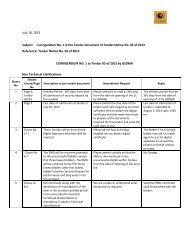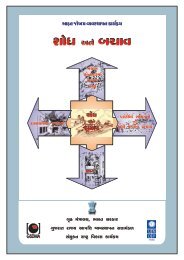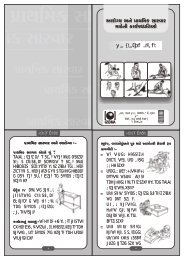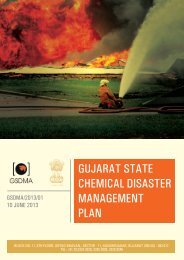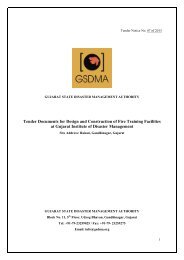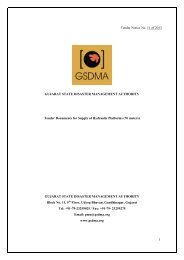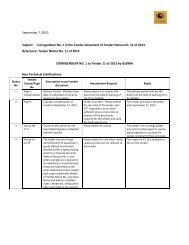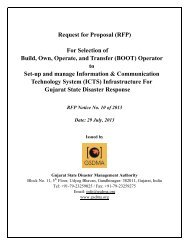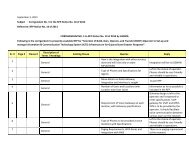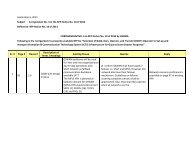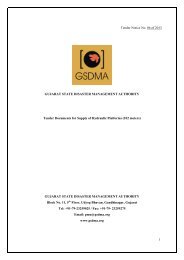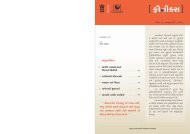Emergency Response Guidebook - Gujarat State Disaster ...
Emergency Response Guidebook - Gujarat State Disaster ...
Emergency Response Guidebook - Gujarat State Disaster ...
You also want an ePaper? Increase the reach of your titles
YUMPU automatically turns print PDFs into web optimized ePapers that Google loves.
SAFETY PRECAUTIONSRESIST RUSHING IN!APPROACH CAUTIOUSLY FROM UPWIND, UPHILL OR UPSTREAM:• Stay clear of Vapour, Fumes, Smoke and Spills• Keep vehicle at a safe distance from the sceneSECURE THE SCENE:• Isolate the area and protect yourself and othersIDENTIFY THE HAZARDS USING ANY OF THE FOLLOWING:• Placards• Container labels• Shipping documents• Rail Car and Road Trailer Identification Chart• Material Safety Data Sheets (MSDS)• Knowledge of persons on scene• Consult applicable guide pageASSESS THE SITUATION:• Is there a fire, a spill or a leak?• What are the weather conditions?• What is the terrain like?• Who/what is at risk: people, property or the environment?• What actions should be taken – evacuation, shelter in-place or dike?• What resources (human and equipment) are required?• What can be done immediately?OBTAIN HELP:• Advise your headquarters to notify responsible agencies and call forassistance from qualified personnelRESPOND:• Enter only when wearing appropriate protective gear• Rescue attempts and protecting property must be weighed against youbecoming part of the problem• Establish a command post and lines of communication• Continually reassess the situation and modify response accordingly• Consider safety of people in the immediate area first, including your ownsafetyABOVE ALL: Do not assume that gases or vapours are harmless because of lack of asmell— odorless gases or vapours may be harmful. Use CAUTION when handling emptycontainers because they may still present hazards until they are cleaned and purged of allresidues.Page 02NOTIFICATION AND REQUEST FOR TECHNICAL INFORMATIONFollow the steps outlined in your organization's standard operating procedures and/orlocal emergency response plan for obtaining qualified assistance. Generally, thenotification sequence and requests for technical information beyond what is availablein this guidebook should occur in the following order:1. NOTIFY YOUR ORGANIZATION/AGENCY• Based on information provided, this will set in motion a series of events• Actions may range from dispatching additional trained personnel to the scene,to activating the local emergency response plan• Ensure that local fire and police departments have been notified2. CALL THE EMERGENCY RESPONSE TELEPHONE NUMBER ON THE SHIPPINGDOCUMENT• If shipping paper is not available, use guidance under next section “ASSISTANCE”3. ASSISTANCE• Contact the appropriate emergency response agency listed on the inside backcover of this guidebook• Provide as much information about the hazardous material and the nature of theincident• The agency will provide immediate advice on handling the early stages of theincident• The agency will also contact the shipper or manufacturer of the material formore detailed information if necessary• The agency will request on-scene assistance when necessary4. PROVIDE AS MUCH OF THE FOLLOWING INFORMATION AS POSSIBLE:• Your name, call-back telephone number, FAX number• Location and nature of problem (spill, fire, etc.)• Name and identification number of material(s) involved• Shipper/consignee/point-of-origin• Carrier name, rail car or truck number• Container type and size• Quantity of material transported/released• Local conditions (weather, terrain)• Proximity to schools, hospitals, waterways, etc.• Injuries and exposures• Local emergency services that have been notifiedPage 03



